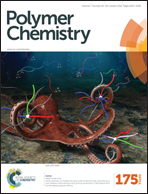Structurally defined nanographene-containing conjugated polymers for high quality dispersions and optoelectronic applications†
Abstract
Novel conjugated polymers such as poly(phenylene-fluorene) P1 and poly(triphenylbenzene-fluorene) P2 with hexaphenylbenzene (HPB) as a pending side group were prepared by Suzuki coupling using the dibromo monomers M1 and M2 with 9,9-dioctylfluorene-2,7-diboronic acid bis(1,3-propanediol) ester, respectively. The HPB moiety of P1 and P2 can be oxidatively cyclodehydrogenated with FeCl3 in nitromethane, yielding polymers P3 and P4 with hexa-peri-hexabenzocoronene (i.e., nanographene) units. The cyclodehydrogenation of nanographene-containing polymers was confirmed by FT-IR spectroscopy. In addition, X-ray powder diffraction of both P3 and P4 revealed a polymer interlayer spacing of 1.3 nm being dominated by the nanographenes. The glass transition temperatures (Tgs) of P1 and P2 were 202 °C and 235 °C, respectively, while both P3 and P4 with nanographenes possessed Tgs higher than 300 °C. Compared to P3, P4 with a triphenylbenzene moiety in its backbone can be well dispersed without aggregation in N-cyclohexyl-2-pyrrolidone (CHP), as confirmed by UV-Vis spectroscopy, photoluminescence spectroscopy (PL) and photoluminescence-excitation (PLE) maps.


 Please wait while we load your content...
Please wait while we load your content...